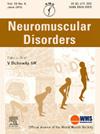Novel c.221+1dup pathogenic variant in AGK gene linked to Sengers syndrome
IF 2.7
4区 医学
Q2 CLINICAL NEUROLOGY
引用次数: 0
Abstract
Sengers Syndrome (SS) is a rare autosomal recessive mitochondrial disorder caused by mutations in the acylglycerol kinase (AGK) gene on chromosome 7, also known as cardiomyopathic mitochondrial DNA depletion syndrome (MTDPS10). This disorder disrupts mitochondrial DNA function and energy metabolism, presenting with symptoms such as congenital cataracts, hypertrophic cardiomyopathy, skeletal myopathy, exercise intolerance, and lactic acidosis. Previous research has shown SS affects oxidative phosphorylation and mitochondrial respiration, implicating the TIM22 complex and carrier import. We report a 32-year-old Palestinian female with a novel homozygous pathogenic variant, c.221+1dup, in the AGK gene. Her clinical presentation included chronic lactic acidosis, congenital cataracts, exercise intolerance, mild hypertrophic cardiomyopathy, and persistent muscle fatigue. Genetic testing was essential for confirming the diagnosis of Sengers Syndrome, revealing this previously undocumented variant. Family history indicated a hereditary pattern with a brother exhibiting similar symptoms. Typically diagnosed in infancy, SS's diverse and rare clinical manifestations can sometimes delay diagnosis. This case emphasizes the importance of considering SS in differential diagnoses when patients present with ocular lesions, lactic acidosis, muscle weakness, and cardiomyopathy. The novel AGK gene variant, with its rarity, highlights the need for heightened clinical suspicion and genetic evaluation, while suggesting further investigation into its pathogenic role and potential founder effects to enhance understanding of the genetic diversity of Sengers Syndrome.
与桑格斯综合征相关的AGK基因c.221+1dup新致病变异
senger综合征(SS)是一种罕见的常染色体隐性线粒体疾病,由7号染色体上的酰基甘油激酶(AGK)基因突变引起,也称为心肌病线粒体DNA缺失综合征(MTDPS10)。这种疾病破坏线粒体DNA功能和能量代谢,表现为先天性白内障、肥厚性心肌病、骨骼肌病、运动不耐受和乳酸酸中毒等症状。先前的研究表明,SS影响氧化磷酸化和线粒体呼吸,涉及TIM22复合物和载体输入。我们报告了一名32岁的巴勒斯坦女性,她的AGK基因中有一种新的纯合致病变异,c.221+1dup。她的临床表现包括慢性乳酸酸中毒、先天性白内障、运动不耐受、轻度肥厚性心肌病和持续性肌肉疲劳。基因检测对于确认seners综合征的诊断至关重要,它揭示了这种以前未记载的变异。家族史显示遗传模式,兄弟表现出类似症状。SS通常在婴儿期诊断,其多样而罕见的临床表现有时会延误诊断。这个病例强调了当患者出现眼部病变、乳酸性酸中毒、肌肉无力和心肌病时,在鉴别诊断中考虑SS的重要性。由于AGK基因变异的罕见性,因此需要加强临床怀疑和遗传评估,同时建议进一步研究其致病作用和潜在的创始效应,以加强对seners综合征遗传多样性的认识。
本文章由计算机程序翻译,如有差异,请以英文原文为准。
求助全文
约1分钟内获得全文
求助全文
来源期刊

Neuromuscular Disorders
医学-临床神经学
CiteScore
4.60
自引率
3.60%
发文量
543
审稿时长
53 days
期刊介绍:
This international, multidisciplinary journal covers all aspects of neuromuscular disorders in childhood and adult life (including the muscular dystrophies, spinal muscular atrophies, hereditary neuropathies, congenital myopathies, myasthenias, myotonic syndromes, metabolic myopathies and inflammatory myopathies).
The Editors welcome original articles from all areas of the field:
• Clinical aspects, such as new clinical entities, case studies of interest, treatment, management and rehabilitation (including biomechanics, orthotic design and surgery).
• Basic scientific studies of relevance to the clinical syndromes, including advances in the fields of molecular biology and genetics.
• Studies of animal models relevant to the human diseases.
The journal is aimed at a wide range of clinicians, pathologists, associated paramedical professionals and clinical and basic scientists with an interest in the study of neuromuscular disorders.
 求助内容:
求助内容: 应助结果提醒方式:
应助结果提醒方式:


